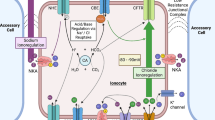Summary
-
1.
To investigate whether the Na permeability of the resting membrane is determined predominantly by the excitable Na channel, we examined the effects of tetrodotoxin (TTX) and the complete removal of external Na+ on the resting potential.
-
2.
In the intact squid axon bathed in K-free artificial seawater, both TTX and the removal of Na+ produced small hyperpolarizations. The effect of Na removal, however, was larger than that of TTX.
-
3.
In the perfused squid axon, the hyperpolarization produced by the removal of external Na+ was greatly enhanced when the internal K concentration ([K+]i) was reduced. The effect of TTX, on the other hand, was not sensitive to the [K+]i or to the membrane potential. For [K+]i = 50 mM and [K+]o = 0, the average hyperpolarization produced by TTX was 1.2 mV, while the hyperpolarization produced by Na removal was approximately 21 mV.
-
4.
The difference between these two effects suggests that the majority of the resting Na current passes through pathways other than the excitable Na channel.
Similar content being viewed by others
References
Armstrong, C. M., and Binstock, L. (1965). Anomalous rectification in the squid giant axon injected with tetraethylammonium chloride.J. Gen. Physiol. 48859–872.
Baker, P. F., Hodgkin, A. L., and Meves, H. (1964). The effect of diluting the internal solution on the electrical properties of a perfused giant axon.J. Physiol. (Lond.)170541–560.
Baker, P. F., Blaustein, M. P., Keynes, R. D., Manil, J., Shaw, T. I., and Steinhardt, R. A. (1969). The ouabainsensitive fluxes of sodium and potassium in squid giant axons.J. Physiol. (Lond.)200459–496.
Carpenter, D. O., and Alving, B. O. (1968). A contribution of an electrogenic Na+ pump to membrane potential in Aplysia neurons.J. Gen. Physiol. 52 1–21.
Chang, D. C. (1983a). Ion-selectivity and “gating” properties of the conductance pathways in squid axon: The view of a membrane-cortex model. InStructure and Function in Excitable Cells (Chang, D. C., Tasaki, I., Adelman, W. J., Jr., and Leuchtag, H. R., Eds.), Plenum, New York, pp. 227–254.
Chang, D. C. (1983b). Dependence of cellular potential on ionic concentrations: Data supporting a modification of the constant field equation.Biophys. J. 43 149–156.
Curtis, H. J., and Cole, K. S. (1940). Membrane resting and action potentials from the squid giant axon.J. Cell Comp. Physiol. 19 135–144.
De Weer, P., and Geduldig, D. (1973). Electrogenic sodium pump in squid giant axon.Science 179 1326–1328.
Freeman, A. R. (1971). Electrophysiological activity of tetrodotoxin on the resting membrane of the squid giant axon.Comp. Biochem. Physiol. 40A71–82.
French, R. J., and Wells, J. B. (1977). Sodium ions as blocking agents and charge carriers in the potassium channel of the squid giant axon.J. Gen. Physiol. 70707–724.
Hille, B. (1975). Ionic selectivity of Na and K channels of nerve membranes. InMembranes, Vol. 3. Lipid Bilayers and Biological Membranes: Dynamic Properties (Eisenman, G., Ed.), Marcel Dekker, New York, pp. 255–323.
Hodgkin, A. L. (1958). Ionic movement and electrical activity in giant nerve fibres.Proc. Roy. Soc. Lond. (Biol.)148 1–37.
Hodgkin, A. L., and Katz, B. (1949). The effect of sodium ions on the electrical activity of the giant axon of the squid.J. Physiol. (Lond.)10837–77.
Junge, D. (1981). Metabolic pumps and membrane potentials. InNerve and Muscle Excitation, Sinauer Associates, Sunderland, Mass., pp. 179–193.
Kao, C. Y. (1966). Tetrodotoxin, saxitoxin and their significance in the study of excitation phenomena.Pharmacol. Rev. 18997–1049.
Khodorov, B. I. (1983). Modification of voltage-sensitive sodium channel by Batrachotoxin. InStructure and Function in Excitable Cells (Chang, D. C., Tasaki, I., Adelman, W. J., Jr., and Leuchtag, H. R., Eds.), Plenum Press, New York, pp. 281–306.
Kuffler, S. W., and Nicholls, J. G. (1976). Control of membrane permeability. InFrom Neuron to Brain: A Cellular Approach to the Function of the Nervous System, Sinauer Associates, Sunderland, Mass., pp. 106–131.
Narahashi, T., Moore, J., and Scott, W. R. (1964). Tetrodotoxin blockage of sodium conductance increase in lobster giant axons.J. Gen. Physiol. 47965–974.
Narahashi, T., Albuquerque, E. X., and Deguchi, T. (1971). Effects of batrachotoxin on membrane potential and conductance of squid giant axons.J. Gen. Physiol. 58 54–70.
Oxford, G. S., and Adams, D. J. (1981). Permeant cations alter K channel kinetics and permeability.Biophys. J. 33:70a.
Perry, J. G., McKinney, L., and De Weer, P. (1978). The cellular mode of action of the anti-epileptic drug 5,5-diphenylhydantoin.Nature 272271–273.
Tasaki, I., and Hagiwara, S. (1957). Demonstration of two stable potential states in the squid giant axon under tetraethylammonium chloride.J. Gen. Physiol. 40859–885.
Yamagishi, S., and Grundfest, H. (1971). Contributions of various ions to the resting and action potentials of crayfish medial giant axons.J. Membrane Biol. 5345–365.
Author information
Authors and Affiliations
Rights and permissions
About this article
Cite this article
Chang, D.C., Liu, J. A comparative study of the effects of tetrodotoxin and the removal of external Na+ on the resting potential: Evidence of separate pathways for the resting and excitable Na currents in squid axon. Cell Mol Neurobiol 5, 311–320 (1985). https://doi.org/10.1007/BF00755398
Received:
Revised:
Accepted:
Issue Date:
DOI: https://doi.org/10.1007/BF00755398




